
Sibiu County is a county of Romania, in the historical region of Transylvania. Its county seat is the namesake town of Sibiu.
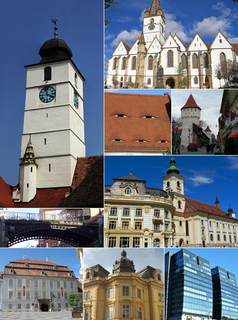
Sibiu is a city in Romania, in the historical region of Transylvania. Located some 275 km (171 mi) north-west of Bucharest, the city straddles the Cibin River, a tributary of the river Olt. Now the capital of the Sibiu County, between 1692 and 1791 and 1849–65 Sibiu was also the capital of the Principality of Transylvania.
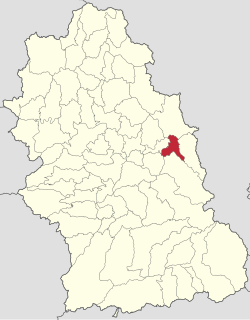
Orăștie is a city in Hunedoara County, south-western Transylvania, central Romania.

The Transylvanian Saxons are a people of German ethnicity who settled in Transylvania in waves starting from the mid-12th century until the mid 19th century.

Avrig is a town in Sibiu County, Transylvania, central Romania. It has a population of 12,815 and the first documents attesting its existence date to 1346. It officially became a town in 1989, as a result of the Romanian rural systematization program.
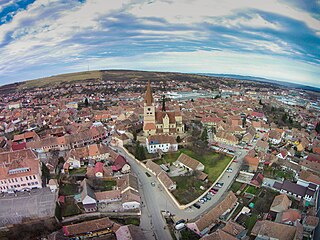
Cisnădie is a town in Sibiu County, Transylvania, central Romania, approximately 10 kilometres (6.2 mi) south of Sibiu. One village, Cisnădioara, is administered by the town.

The Germans of Romania represent one of the most significant historical ethnic minorities of Romania. During the interwar period, the total number of ethnic Germans in this country amounted to as much as c. 800,000, a figure which has subsequently fallen to c. 36,000.

Tălmaciu is a town in Sibiu County, in central Romania, 20 km (12 mi) south of the county seat, Sibiu. It lies on the eastern end of the Mărginimea Sibiului area.

The Protestant Theological Institute is a Protestant seminary and private university in Cluj-Napoca, Romania. The state-recognized institution trains ministers for four separate Protestant denominations: Calvinism, Lutheranism, and Unitarianism.
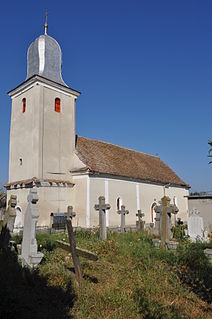
Cergău is a commune located in Alba County, Transylvania, Romania. It has a population of 1,747 and is composed of three villages: Cergău Mare, Cergău Mic (Bolgárcserged) and Lupu (Farkastelke).

Bazna is a commune located in Sibiu County, Transylvania, Romania. It is composed of three villages: Bazna, Boian and Velț. It lies 13 km (8.1 mi) northeast of Mediaș, within the catchment area of the Târnava Mică River.

Laslea is a commune located in Sibiu County, Transylvania, Romania. It is composed of five villages: Florești, Laslea, Mălâncrav, Nou Săsesc, and Roandola. In Romanian, Florești was known as Felța until 1950.
The following is a timeline of the history of the city of Sibiu, Transylvania, Romania.

Octavian or Octav Smigelschi was an Austro-Hungarian painter and printmaker, one of the leading culturally Romanian artists in his native Transylvania. Of mixed Polish, Aromanian, and possibly Ruthenian, background, he identified mainly with the Romanian-speaking Greek-Catholics, although some of his most important work was also done for the rival Romanian Orthodox Church. Smigelschi studied under Bertalan Székely at the Drawing School and Art Teachers' College in Budapest, becoming familiar with the historicist trend in contemporary Hungarian art. While working on and off at high schools in Upper Hungary and Transylvania, he experimented with borrowings from ancient Romanian handicrafts. Smigelschi's European journeys with Arthur Coulin took him to Cervara di Roma, where he studied Renaissance art, while moving away from academic art and into Symbolism and Art Nouveau.

Ioan Axente Sever was a Romanian revolutionary in Austria-Hungary who participated in the Transylvanian Revolution of 1848.
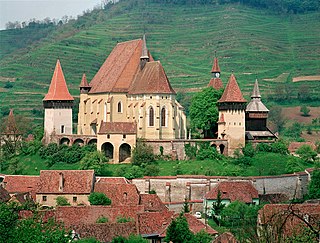
The Biertan fortified church is a Lutheran fortified church in Biertan (Birthälm), Sibiu County, in the Transylvania region of Romania. It was built by the ethnic German Transylvanian Saxon community at a time when the area belonged to the Kingdom of Hungary. Briefly Roman Catholic, it became Lutheran following the Reformation. Together with the surrounding village, the church forms part of the villages with fortified churches in Transylvania UNESCO World Heritage Site.

Vasile Moga was an Imperial Austrian ethnic Romanian bishop of the Romanian Orthodox Church. A native of Sebeș, he was a parish priest for some years before being made bishop of Transylvania. The first Romanian to hold this office in over a century, he served for over three decades. Living in Sibiu during this period, he worked both to improve the spiritual and educational foundations of the diocese and to secure additional rights for the province's Romanians.

Asociația Fotbal Club Hermannstadt, commonly known as FC Hermannstadt, Hermannstadt or familiarly as Sibiu, is a Romanian professional football club based in the city of Sibiu, Sibiu County, which currently competes in Liga I.

Dimitrie Comșa was an Imperial Austrian-born Romanian agronomist and political activist.

Daniil Popovici-Barcianu was an Austro-Hungarian ethnic Romanian teacher, naturalist and political activist.



















